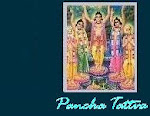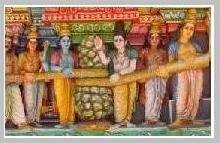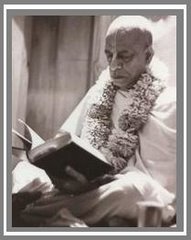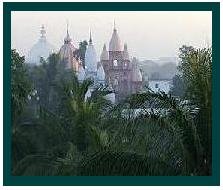
We who have come to the Sri Chaitanya Math are all surrendered to Sri Chaitanya Deva, therefore we do not have any other goal besides devotional service to the Supreme Lord. If we lack in our service, then our mentality will become like that of a materialistic person and ultimately devour us. In order to protect the math, however, we have to abide by some rules.
1. It should be the duty of a sannyasi that they should never use shoes, rather they should go everywhere on foot.
2. They should never accept service from anyone. Neither should they never ask someone to massage their body or feet with oil.
3. Eating nice food and eating separately from other devotees is totally forbidden.
4. One should never go to a physician and should never take medicine according to their own wish.
(Note) When a sannyasi needs something then it should be the duty of residents of the math to nicely take care of him. It is the duty of a sannyasi to serve the ones who are not sannyasis. The living entity invites difficulties by criticizing others, scandalizing others and unnecessarily talking about others. One should always desire auspiciousness. A devotee can easily control his mind and destroy his desires by steadfastly serving the Holy Name.
5. The Supreme Personality of Godhead Sri Krsna is residing in every spirit soul, therefore one should not consider himself worshipable and that others should serve him. When a sannyasi is free from false ego then the residents of the math should enthusiastically serve him, otherwise he should go back home.
6. Excessive foppery,excessive drinking of milk, eating luxuriously like a big man, should be totally given up. We don't want gymnasts (body builders) in our math. This is the place for the devotees of the Lord.
7. Strengthening the senses by taking excessive medicine and trying to spread one's domination in order to attract other's wives should be given up totally.
8. Sri Krsna is the only Lord and Enjoy er of everybody and everything. One should remember that all the time. One should serve according to the degree of their devotion. There cannot be any auspiciousness unless we become free from the evil desire to use the devotees in our service. The fire of lust that burns for material sense gratification should be given up. But that doesn't mean one should speak uncivilized language and dress in an uncivilized way in order to mix with dignified society.
9. A bramachari should not desire to become a sannyasi simply in order to have greater sense gratification. The desire to dominate is detrimental to devotional service. To consider a sense enjoy er to be a sannyasi, and wanting to become a sannyasi with that ideal should be totally rejected. When one begins to enjoy his senses and becomes deceptive, he cannot serve the Lord nor His devotees.
10. One should be very careful that no mood of foppery enters into Sri Chaitanya Math which will to ruin the sannyasis and bramacharis. The examples we are having about should not be tolerated, the householders also, like a sannyasi, should overcome the urges of lust, anger and greed. Everyone should consider himself to be very low and serve the residents of the math and the other Vaishnavas with all humility.
11.Those who are not residents of the math, but are staying in the math for some business, or wanting some favor from the math should always be willing to serve the residents of the math and the math itself. The residents of the math should never behave indecently with a guest of the math.
12.The residents should reject the mentality that the math is their personal property and that the guests are merely objects of their mercy. A guest should be treated with the highest honor - actually everybody in this world should be respected. Otherwise we may land up in the same extreme distress the materialists are suffering. A resident of the math should remember all these things very carefully. One should always serve Sri Krsna, there shouldn't be any mistake in that and more indispensable is the service to a Vaishnava.
13. If a sannyasi must go to the shop or the dispensary for some reason other than service to the math, then he should go on foot. Let the car be sitting empty, but still they will not get into it. What everybody else gets, they should receive only that.
14. Never should they use any conveyance, but with the excuse of going to the doctor, they take the car. They buy medicine and eat luxurious food. If they again behave properly for one year, then their eligibility can be considered. The math is not the place for foppery or staying in a hospital. One should not display his foppery. They can better behave that way by staying at home. Instead of saffron cloth they may be clad in white with a tail and send them back home. The ones who desire foppery, luxurious food and medicine they can go back to their homes and take care of their families, then they won't have to identify themselves with the math.
Everybody should be reminded that cars, horses, launches and indeed men, are all meant for the use of the math, not any individuals display of foppery.
15. Luxurious eating should be totally stopped.
The sannyasis who do not indulge in foppery, should be recognized as Gaudiya Math sannyasis. The rest should be sent back to their respective homes. If our man power decreases due to that, that is still better. The ones who have taken shelter of the math, but are simply motivated by their bellies and genitals, if they are driven away, then the expenses of the math will be reduced. The pleasure-loving, sense gratifying managers should not be allowed to waste money rather everyone should earn for the math. It is important to make a list of how much one earns. It is not necessary to eat, buy medicine and display foppery more than one earns. The ones who come to render devotional service are bramacharis, grhasthas, vanaprasthas and sannyasis. To the ones who do not render any devotional service, the math will not give them shelter, because they do not deserve it.
16. One should never think: "I have rendered a lot of service to the math so I will use their car." This is the mentality of a materialist. One who is serving the math should do that without any expectation of return because everyone has come to serve the math. If anyone takes anything in return of his service to the math or serves himself, he will become a sense gratifier. When one is a guest, then he cannot demand, he should eat according to the wishes of the host. One who is busy seeking sense gratification should be asked to leave.
1. It should be the duty of a sannyasi that they should never use shoes, rather they should go everywhere on foot.
2. They should never accept service from anyone. Neither should they never ask someone to massage their body or feet with oil.
3. Eating nice food and eating separately from other devotees is totally forbidden.
4. One should never go to a physician and should never take medicine according to their own wish.
(Note) When a sannyasi needs something then it should be the duty of residents of the math to nicely take care of him. It is the duty of a sannyasi to serve the ones who are not sannyasis. The living entity invites difficulties by criticizing others, scandalizing others and unnecessarily talking about others. One should always desire auspiciousness. A devotee can easily control his mind and destroy his desires by steadfastly serving the Holy Name.
5. The Supreme Personality of Godhead Sri Krsna is residing in every spirit soul, therefore one should not consider himself worshipable and that others should serve him. When a sannyasi is free from false ego then the residents of the math should enthusiastically serve him, otherwise he should go back home.
6. Excessive foppery,excessive drinking of milk, eating luxuriously like a big man, should be totally given up. We don't want gymnasts (body builders) in our math. This is the place for the devotees of the Lord.
7. Strengthening the senses by taking excessive medicine and trying to spread one's domination in order to attract other's wives should be given up totally.
8. Sri Krsna is the only Lord and Enjoy er of everybody and everything. One should remember that all the time. One should serve according to the degree of their devotion. There cannot be any auspiciousness unless we become free from the evil desire to use the devotees in our service. The fire of lust that burns for material sense gratification should be given up. But that doesn't mean one should speak uncivilized language and dress in an uncivilized way in order to mix with dignified society.
9. A bramachari should not desire to become a sannyasi simply in order to have greater sense gratification. The desire to dominate is detrimental to devotional service. To consider a sense enjoy er to be a sannyasi, and wanting to become a sannyasi with that ideal should be totally rejected. When one begins to enjoy his senses and becomes deceptive, he cannot serve the Lord nor His devotees.
10. One should be very careful that no mood of foppery enters into Sri Chaitanya Math which will to ruin the sannyasis and bramacharis. The examples we are having about should not be tolerated, the householders also, like a sannyasi, should overcome the urges of lust, anger and greed. Everyone should consider himself to be very low and serve the residents of the math and the other Vaishnavas with all humility.
11.Those who are not residents of the math, but are staying in the math for some business, or wanting some favor from the math should always be willing to serve the residents of the math and the math itself. The residents of the math should never behave indecently with a guest of the math.
12.The residents should reject the mentality that the math is their personal property and that the guests are merely objects of their mercy. A guest should be treated with the highest honor - actually everybody in this world should be respected. Otherwise we may land up in the same extreme distress the materialists are suffering. A resident of the math should remember all these things very carefully. One should always serve Sri Krsna, there shouldn't be any mistake in that and more indispensable is the service to a Vaishnava.
13. If a sannyasi must go to the shop or the dispensary for some reason other than service to the math, then he should go on foot. Let the car be sitting empty, but still they will not get into it. What everybody else gets, they should receive only that.
14. Never should they use any conveyance, but with the excuse of going to the doctor, they take the car. They buy medicine and eat luxurious food. If they again behave properly for one year, then their eligibility can be considered. The math is not the place for foppery or staying in a hospital. One should not display his foppery. They can better behave that way by staying at home. Instead of saffron cloth they may be clad in white with a tail and send them back home. The ones who desire foppery, luxurious food and medicine they can go back to their homes and take care of their families, then they won't have to identify themselves with the math.
Everybody should be reminded that cars, horses, launches and indeed men, are all meant for the use of the math, not any individuals display of foppery.
15. Luxurious eating should be totally stopped.
The sannyasis who do not indulge in foppery, should be recognized as Gaudiya Math sannyasis. The rest should be sent back to their respective homes. If our man power decreases due to that, that is still better. The ones who have taken shelter of the math, but are simply motivated by their bellies and genitals, if they are driven away, then the expenses of the math will be reduced. The pleasure-loving, sense gratifying managers should not be allowed to waste money rather everyone should earn for the math. It is important to make a list of how much one earns. It is not necessary to eat, buy medicine and display foppery more than one earns. The ones who come to render devotional service are bramacharis, grhasthas, vanaprasthas and sannyasis. To the ones who do not render any devotional service, the math will not give them shelter, because they do not deserve it.
16. One should never think: "I have rendered a lot of service to the math so I will use their car." This is the mentality of a materialist. One who is serving the math should do that without any expectation of return because everyone has come to serve the math. If anyone takes anything in return of his service to the math or serves himself, he will become a sense gratifier. When one is a guest, then he cannot demand, he should eat according to the wishes of the host. One who is busy seeking sense gratification should be asked to leave.
Your ever well wisher, Sri Siddhanta Saraswati

























